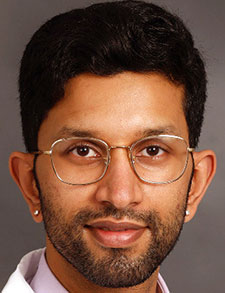 For some early career hospitalists, it can take years to realize the value of networking. Some practitioners in their first years on the job can get caught up in the day-to-day work and not appreciate the insights and importance of talking to the people who did that job before them.
For some early career hospitalists, it can take years to realize the value of networking. Some practitioners in their first years on the job can get caught up in the day-to-day work and not appreciate the insights and importance of talking to the people who did that job before them.
Not Rasan Cherala, MD, and not the SHM Long Island Chapter he now leads as president.

Dr. Cherala
“As a trainee and a new budding hospitalist, having that ability to network with other people who have been through similar experiences that I’ve been through is important,” he said. “But also as someone who has a large interest in getting into the administrative aspect of hospital medicine, it has been a great opportunity to meet with other leaders in hospital medicine both locally and on a national level.”
Dr. Cherala, an attending hospitalist at Stony Brook Medicine in Stony Brook, N.Y., sees attracting younger hospitalists to the chapter as “the driving focus.”
“This year we’ve instituted both a medical student liaison and a medical resident liaison, which are kind of newer positions than what we’ve had in the past, with the idea of targeting that younger population,” he said.
“We’ve actually had a number of medical students and residents come to our last hospitalist meeting…it’s interesting because a lot of them know about different subspecialties, but they had no clue what hospital medicine was. I think it’s a great introduction to them to know exactly what being a hospitalist means.”
But whether it’s residents or relative veterans, the sales pitch of teamwork and networking is what Dr. Cherala touts as the chapter’s value.
“Oftentimes, hospitalists at each of (our local) health systems are siloed,” he said. “And their experience is limited to the health system that they work in. It can feel like the problems you deal with on a day-to-day basis are unique to your institution. But it’s very common to see those challenges across different hospital systems, and having access to the ideas and other interventions that hospitalists are doing at other institutions can give you a broader perspective in dealing with those issues.”
Take burnout, perhaps the preeminent issue facing a generation of hospital staffers who have spent years dealing with the COVID-19 pandemic and its wake.
“When you’re starting out as a new hospitalist, or even as a more experienced hospitalist, the field is demanding. You have increasingly sicker patients. Our hospital volumes are going up. I think being able to connect with both your patients and your surrounding community of hospitalists helps prevent you from burning out.”
Collaboration doesn’t end with Long Island hospitalists or hospitals, though. Dr. Cherala is also working with the nearby New York City chapter.
“For us, the challenge is bringing people together from a wider geographic spread,” he said. “Because I think a lot of people don’t realize you can drive three hours on Long Island from the tip to the city.
Some people live much closer to the city, and some people live far out east. We have been working to have our chapter meetings in different locations across the island to kind of allow for people from both ends of the island to come and be present and part of the chapter.”
One facet of that collaboration is a poster competition, always one of the more popular annual features of a chapter. The resident and medical student abstract competition was held at the end of November.
It “is something we’ve been working on a lot with the New York City chapter to push for, I think, both as an experience to continue this outreach toward medical students and residents, but also to give them a little bit broader exposure to what happens at Converge and on the national level of SHM,” Dr. Cherala said. “That’s a large initiative that we’re working on currently that we’re all pretty excited about.”
Dr. Cherala’s approach to cultivating younger members, participants from multiple health systems, and participants from the widest possible geographic swath is to have a more “unified” chapter in five years.
“A more unified membership where we have that inter-hospital network collaboration,” he said. “And where we have regular attendance of both hospital leaders and hospitalists from all those different hospital systems.
“I think, traditionally, in the past, there has been an alternating leadership between one health system and the other. And I think part of the value of having an SHM Long Island chapter is having people from all of those different systems together.”
Richard Quinn is a freelance writer in New Jersey.